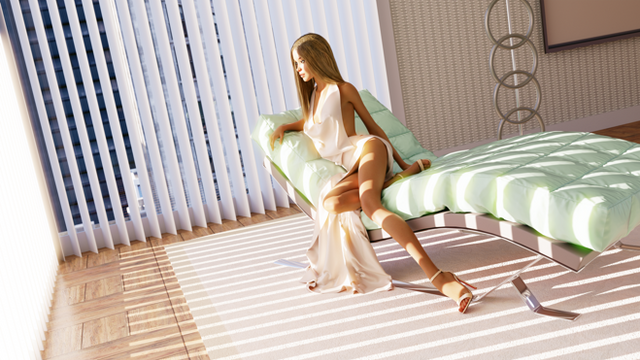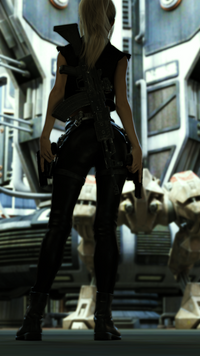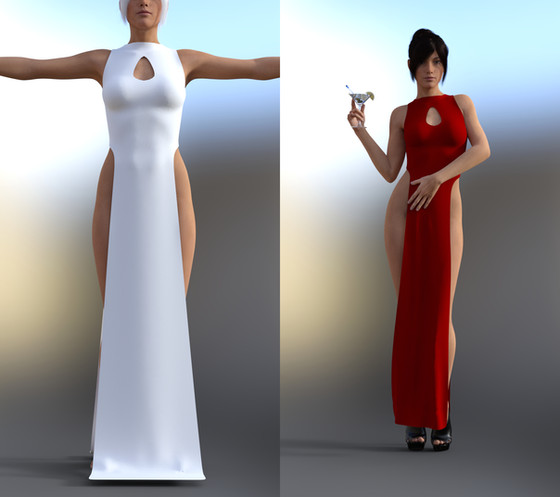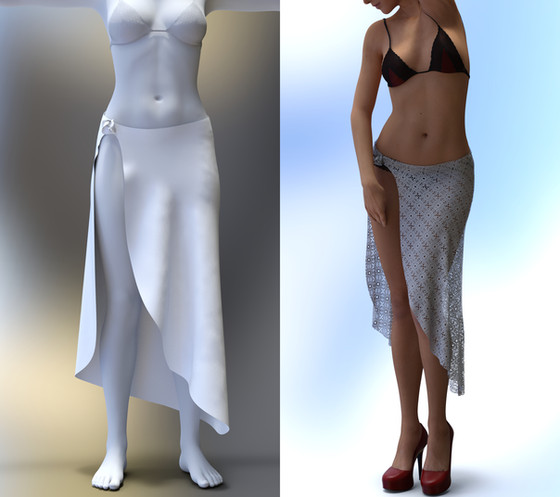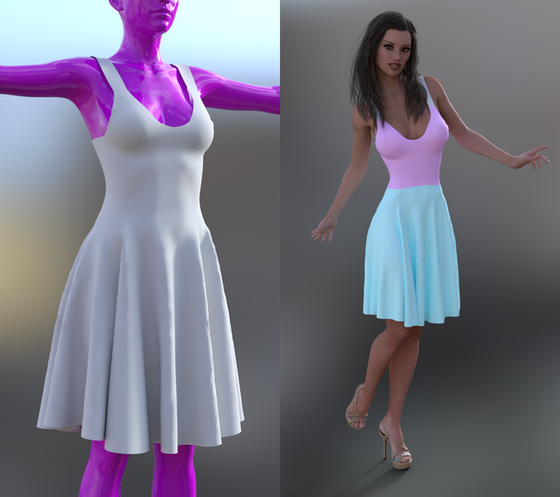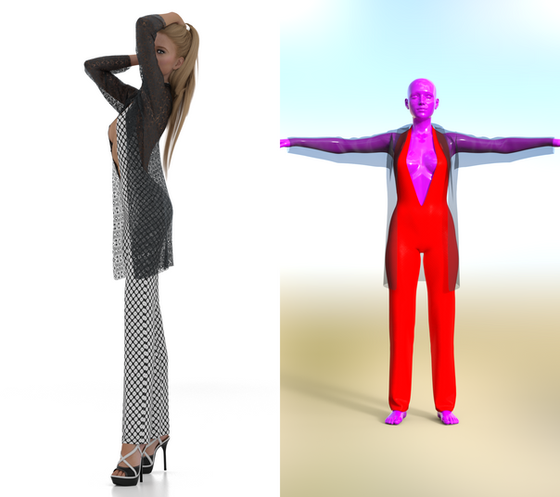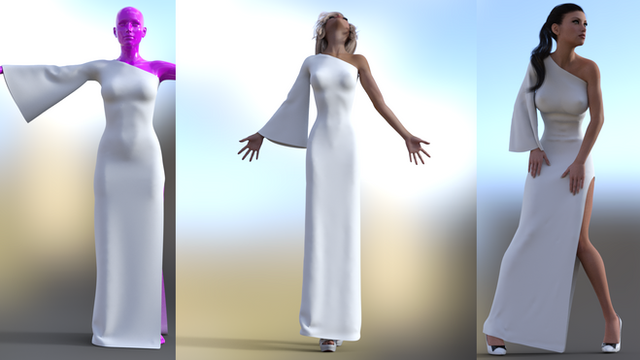HOME | DD
 soup-sammich — Daz Transfer Utility To dForce Cloth Tutorial
soup-sammich — Daz Transfer Utility To dForce Cloth Tutorial

#iray #conformingcloth #tutorial #tutorials #daz3dstudio #dforce #irayrender #genesis8female #dforcecloth #dforceclothing
Published: 2019-01-29 23:03:38 +0000 UTC; Views: 28846; Favourites: 174; Downloads: 344
Redirect to original
Description
So, you've found an .obj clothing file for your favorite generation of Genesis and you want to use it as conforming or dForce cloth in Daz. But, alas, you have no idea where to start. Fear not fellow deviant! The process is fairly simple, just not very obvious. This guide should help you along your path, so let's get started!
Step 1: Select the .obj you want to convert to conforming cloth/dForce in your scene tab. Note the icon next to it is different from the icon next to your model. That's because Daz visually clues you in on the type of content you're looking at in the scene. From the best I can determine, weighted/rigged figures are three "empty" hexagons, figures that have not been weighted/rigged are "shaded" hexagons, non-figures without rigging are a "shaded" cube, and content made from multiple non-figure items (usually rigged props) are "empty" cubes. (Note to anyone who knows for sure, please let me know in the comments below! 
Step 2a: With your cloth .obj still selected, open the Transfer Utility by navigating to Edit>Object>Transfer Utility. In the window that pops up, select your "Source: Scene Item." This needs to be your intended parent figure, NOT the cloth. Select your "Target: Scene Item" next. This is where you will select your cloth .obj. For the purposes of this tutorial, we'll leave the "Item Shape" drop downs both at "Default." From here, it is optional to select a Projection Template. The Projection Templates can be quite helpful for the automated weight map process the Transfer Utility performs. If there is a Projection Template that matches your clothing item, I recommend you select it, or the closest one available. The folks at Daz have created the templates to assist in the automated weight mapping process the Transfer Utility performs. These templates are exceptionally helpful for dresses/skirts or anything that bridges the area between a figure's legs.
Step 2b: There are additional options shown in the image above, click on "Show Options" to see these. I usually don't play with the defaults here, the folks at Daz have done a pretty good job of getting everything set to convert the majority of clothing items. I do usually check the boxes for "Add Smoothing Modifier" and "Content Type" (finding the appropriate Follower option in the drop down). The latter is only important if you want to distribute your model through the Daz Install Manager. When you're done tweaking (or not tweaking), click Accept. Daz will do its thing and convert the cloth to a figure, it will use the "Source: Scene Item" weight maps to apply weight maps to the item. This weight map will be augmented with the weight map of whatever you have chosen as the Projection Template. After Daz is done working its magic, you'll see in your Scene Tab that your cloth has been converted to a figure and parented/fit to your model. If you're going for just conforming cloth, read the next note and skip to the conclusion information now if you so choose.
Note: Functionally, I haven't noticed a difference between the Transfer Utility found in Object vs. the one found in Figure, BUT there may be some differences behind the scenes. I'd rather err on the side of caution and use the correct Transfer Utility for what I'm working with. Note, if your cloth has a "hexagons" icon, it is a figure, and you should probably use the Figure>Transfer Utility instead.
Step 3: Now for dForce! Hurray dynamic cloth! If you don't already have a Simulation Settings tab in your workspace, you'll need to go to Window>Panes (Tabs)>Simulation Settings. If you plan on doing a lot with dForce you may want to dock this pop up pane somewhere easy to get to. Once you've got your Simulation Settings tab opened, select the "Options List." It's a little icon close to your Viewport (depending on what side of the Viewport you docked the tab) and looks like a "Right Arrow" with lots of horizontal lines next to it. This is a "Tab Sensitive" options list and will give you options specific to the selected tab. Navigate to dForce>Add dForce Modifier: Dynamic Surface. From here, you'll want to follow my dforce Basic Walkthrough to get the ball rolling on your drape.
Conclusion: This is just the BASICS of conforming cloth and dforce clothing creation. In order to achieve the absolute best results you'll need to familiarize yourself with weight mapping in Daz. I still struggle with weight mapping, but I'm getting the hang of it. Don't expect to get it right on the first try. Assuming the cloth fits fairly snugly to the figure, you probably won't have to do much weight map tweaking. The problem areas are usually the groin and arm pits of the figure. These areas usually require a lot of "smoothing" work, and sometimes a redesign of the cloth .obj. In my limited testing, I haven't noticed too many weight issues with G8 figures, but I've only done a few (and REALLY snug) cloths for G8F, so your results may vary.
***IMPORTANT*** Unless your item is designed specifically for your morphed figure, use the default figure for this process. Once the clothing item has been fit to the default figure any morphs you apply to the figure will also be applied to your cloth.
Have fun, and bask in your new found awesomeness! 

Related content
Comments: 43

👍: 0 ⏩: 1

👍: 0 ⏩: 0

👍: 0 ⏩: 1

👍: 0 ⏩: 1

👍: 0 ⏩: 0

👍: 0 ⏩: 1

👍: 0 ⏩: 1

👍: 0 ⏩: 1

👍: 0 ⏩: 0

Hehe, that will take some times to study. Great found on a late evening
👍: 0 ⏩: 1

👍: 0 ⏩: 0

Thanks! Hopefully you find it useful!
👍: 0 ⏩: 0

Lots of detail and work. Thanks for sharing. One of these days I WILL get back to my 3D art. This will come in handy.
👍: 0 ⏩: 1

More power to you! And thank you!
👍: 0 ⏩: 0

Have fun, and many successes!
👍: 0 ⏩: 0

Thanks for the info. I'll get into dressmaking one day
👍: 0 ⏩: 1

No problem! And if you like doing something that always has another problem to solve, 3D clothing creation definitely fits that bill! 
👍: 0 ⏩: 1

And hey look! It even works.
You weren't just pretending to be clever were ya
Now all I gotta do is learn how to make a dress that isn't complete shit.
👍: 0 ⏩: 1

Nicely done! And there is some method to my madness, not all pretend!
And the dress isn’t complete shit... It’s a simplistic design that looks quite good! 
👍: 0 ⏩: 1

Cheers.
Was only a very basic cut, just to experiment and see how to stitch things up. Then tested the import and transfer thing. It worked, I have those basics down now.
👍: 0 ⏩: 1

Excellent! Basic cuts are definitely the place to start.
👍: 0 ⏩: 1

I might try and put a couple of straps on it, and some trim as well, make it a bit fancier. Tomorrow maybe. I only doing a trial version, but it's on a huge sale till 18th so if I can avoid the dentist I can get it.
👍: 0 ⏩: 1

Wow! That is one helluva sale! Grab it and buy a lot of Aspirin with your savings!
👍: 0 ⏩: 0

Really useful as always. Would just like to emphasize that in my experience the little note at the end is vitally important. I think I have also seen after numerous failed efforts that the figure MUST be in the zero pose. This is a bit too bad as I would like to follow this technique to avoid unwanted deformations to parts of clothing when applying shapes to the figures but I haven't been able to get that to work.
👍: 0 ⏩: 1

Thanks! As for the last bit, I can help there, but I think I’ll need to figure out video/audio capture before I can do a tutorial on that. For now, look for documentation on Joint Control Morphs (JCMs). That should get you started in the right direction.
👍: 0 ⏩: 0

